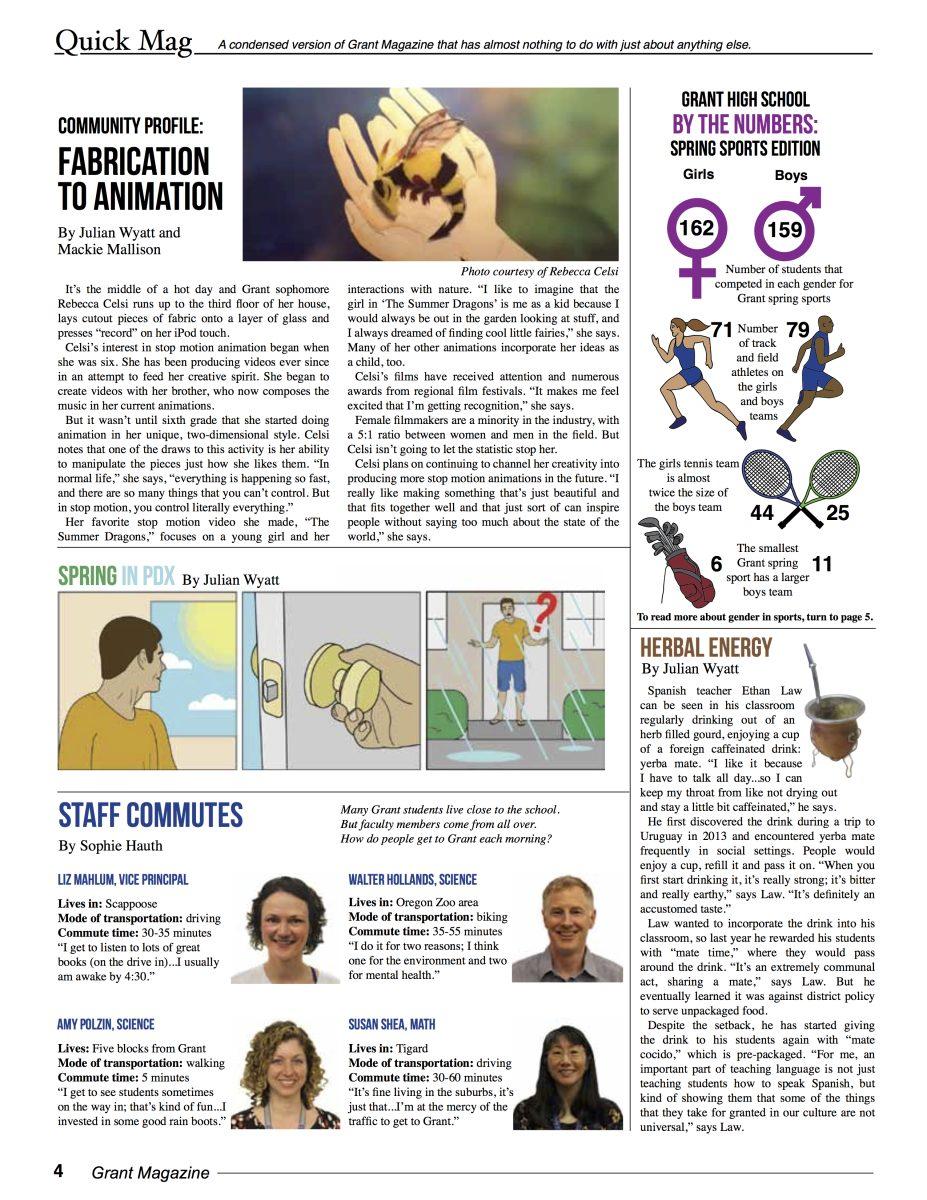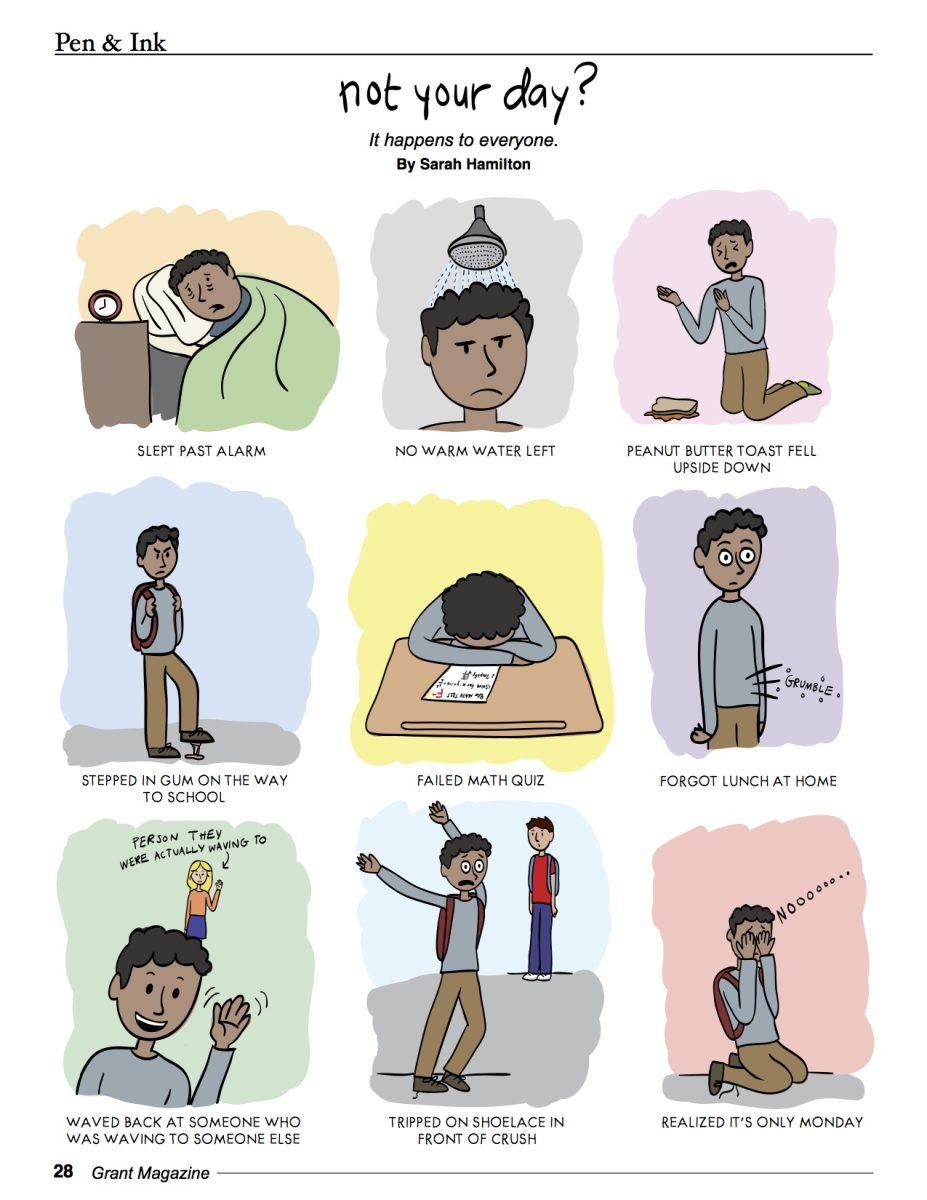
When the long-awaited lunch bell rings at Grant High School, students shuffle out of their classes, eager for something to eat.
Some gather with friends in Center Hall before heading out to McDonald’s or New Seasons. Others sit together on the hallway floor, leaning against their lockers.
Meanwhile, a much smaller group ventures downstairs into the cafeteria. Those students file through lunch lines and congregate at tables in different corners of the room. Some make their way back upstairs after getting food, but most stay put.
The scene plays out daily. It’s almost as if there are two different worlds when it comes to the Grant lunch scene – a system that most students at the school have gotten used to. In practice, it has become part of the school’s fabric.
And with it comes a concern by students, administrators and others that the cafeteria represents a classist culture that puts a negative check on low-income students.
“It’s almost as if you get a stigma, a social stigma against you for (eating in the cafeteria)…Why is it this idea that exists around Grant that if you’re anybody, you don’t eat in the cafeteria?” asks junior Mike Meo, who eats in the cafeteria regularly. “If you’re anybody of worth, you don’t do that.”
Statistics show about 30 percent of students at Grant are eligible to receive free and reduced lunch. That means the cafeteria has become a destination for people who can’t afford to go off campus for lunch. Οn an average day, the cafeteria serves about 101 students. Of those, almost three-fourths qualify for a free or reduced lunch.
Tess Fleming, a junior who used to eat in the cafeteria with a friend, agrees that a negative stereotype about the cafeteria permeates the school. “I just feel like at Grant, especially, if you can’t afford to go out to eat or bring your own lunch, it’s like looked down upon,” she says. “It feels like only kids who are on free and reduced lunch eat (in the cafeteria), and so I think a lot of people think if you do eat in the cafeteria…you’re poor.”
Principal Carol Campbell worries about what that means for the school. “I think that this is really a socioeconomic kind of divide in our school. (The cafeteria) is where it really shows up,” she says.
Campbell says most students at Grant have the luxury of choice, whether that’s buying lunch at a nearby restaurant, going to a grocery store or bringing food from home. Many don’t think twice about it, given that Grant has an open campus at lunch. But others, Campbell says, are stuck.
“As a middle school and elementary school student, you’ve eaten in the cafeteria for eight years; now you’re in high school, and suddenly you have this freedom to move about a little more, to make your own choices about what you eat. But kids who have free lunch, they don’t get that,” she says.
The stigma doesn’t apply to everyone. There are a handful of students who bring their own lunch and eat in the cafeteria for the sense of community.
“It’s a really nice place to be where you can totally express yourself without judges,” says Makenzie Swan-Duffy, a sophomore who brings her lunch to the cafeteria daily.
Senior Noah Evans-Kluthe, who identifies as middle class, agrees. “It’s different down here than anywhere else in the school,” he says. “I just like how I’m able to just be a little bit more loud and rambunctious, because that’s my nature.”
But the lunchroom divide is too obvious to ignore. And while the administration has worked to limit racial and gender inequities at Grant, the cafeteria shows that separation along socioeconomic lines has remained largely unchecked.
“The cafeteria…should exemplify unity, and everybody should come together in the cafeteria,” says junior Zach Leonard. “It’s everybody’s favorite time, ‘cause everybody loves lunch.”
• • •
Fifty years ago, Grant’s cafeteria was a different scene.
“It was packed,” says Denny King, a 1961 graduate who remembers his time at Grant fondly. “Everyone had their table. I loved it. It was a very social place.”
While some upperclassmen occasionally went off campus for lunch, most people stayed at school. “I don’t understand at all why nobody would want to go down there,” says King of the cafeteria today. “That’s ridiculous to me.”
Grant – and much of the country – was a different place in the 1960s. Race played a factor in a lot of aspects, and there were tensions at the school.
But King, who was lower middle class when he went to Grant, says people “mixed together pretty well. I don’t ever remember being, you know, put down or made fun of because I had holes in my sleeve.”
Later, in the 1990s, the socioeconomic divide in the school had grown, current English teacher Dylan Leeman recalls. He attended Grant at the time and remembers how classes were “tracked,” meaning that levels of difficulty existed within one subject.
“The lowest levels were taught in the basement and the higher levels were taught in the upper floors, and it really felt icky,” Leeman remembers. “If you had a standard class and honors class meeting the same period, some kids go into the honors and some kids go into the standard, and one of the things you see between those two classes is a huge socioeconomic rift.”
But even then, the cafeteria remained the place where everybody came together. “It had a lot less stigma,” says Leeman, who also describes himself as lower-middle class growing up. He ate in the cafeteria consistently throughout his four years at Grant.
Leeman also remembers better food back then, a table just for athletes, a separate salad bar, more workers behind the counter, and more teachers. It all contributed to a livelier environment.
Vernette Dixon, who began teaching at Grant in 1988, remembers gathering with other teachers in the cafeteria for lunch every day. Faculty members were served a hot lunch along with baked goods.
“It was just kind of like a camaraderie place; it was really nice and I thought we would have it forever,” Dixon recalls.
But by the time Leeman came back as a teacher in 2001, the building had aged and the culture of the cafeteria had changed.
“I don’t know when it happened; maybe it happened when I was gone, before I came back here as an employee, that the cafeteria became smaller staffed, maybe not as good…and not as popular with students,” says Leeman.

Dixon, who now serves as a substitute teacher, remembers beginning to eat lunch in her classroom toward the end of her time at Grant. “Those people who used to (eat in the cafeteria) started retiring, then new people came on…and some of the traditions that we had always had started disappearing,” says Dixon.
For many, these changes made the cafeteria less appealing and students who could afford to looked elsewhere for food.
Today, even top administrators at the district find it vexing that the cafeteria has become a place of last resort for most students.
“When you give students, adults or anyone else options, they will gravitate to the options that appeal to them,” says Lolenzo Poe, the school district’s chief equity and diversity officer and director of partnership development. “So if it is viewed that only poor kids eat lunch there, it’s really interesting that others move away from it…What is in the culture of the school that will want people to separate themselves from those kids?”
By the mid-2000s, the stigma against Grant’s cafeteria was firmly set.
In 2010, then-principal Vivian Orlen, who was known for making dynamic and sometimes controversial changes at Grant, tried to change the cafeteria.
“When I first discovered the cafeteria downstairs, I was really upset by the environment down there,” Orlen recalls. “And even though I knew that not a lot of students ate in the cafeteria, I couldn’t believe how neglected it had been, you know as just a space in the school.”
She worked with art teachers to paint trash cans and add murals. And she ended off-campus lunch for freshmen, hoping to draw more students to the lunchroom. Ultimately, though, she says her changes weren’t successful. And she believes the issue extends beyond the school.
“I think the cafeteria is just the tip of the iceberg,” Orlen says. “In my view, you have a city that has a separation and divide. And then all the schools become mirrors of that divide.”
The question remains whether something can be done to change lunch at Grant. With the divide so ingrained in the school’s culture, it seems a difficult proposition.
“What has caused it to be…the only students who are in the cafeteria are kids on free and reduced lunch?” Poe asks. “If it is that others are opting not to be in the cafeteria because they don’t want to be around those students, then you have to talk about what is equitable in terms of building an environment that is conducive to all kids.”
Since 2001, the percentage of students at Grant on free and reduced lunch has nearly doubled. It’s unclear whether this contributes to the separation at lunch.
Tess Fleming remembers the beginning of her freshman year. “You just come in with this stigma attached to it that you don’t go (in the cafeteria),” she says. “That’s just not what people do. You come in with that bad idea because other people tell you it’s bad.”
Despite the reputation, Fleming spent much of freshmen year in the cafeteria with a friend who qualified for free and reduced lunch. Now, though, Fleming can be found eating upstairs with friends. “The space, what it looks like and the things that they’re serving make a really huge impact on how people feel on the cafeteria,” she says.
Meo has experienced both lunch crowds. During his freshman year, he ate off campus at places like Blind Onion Pizza. But soon, that became too much of a financial burden. Eligible to receive a free subsidized lunch, he switched to eating in the cafeteria during his sophomore year.
Today, both he and his friend, Zach Leonard, stand behind the idea that people avoid the cafeteria because of the income level of the majority of the people who eat there.
“I’m always the one bringing it up, and I’ve asked people, you know, ‘Why don’t you eat in the cafeteria?’ I get all sorts of different responses, like ‘It stinks down there.’ It doesn’t stink down there,” says Meo. “We all know the real reason…it’s an ugly truth that people don’t want to really think about.”

For other Portland high schools, the lunch divide isn’t much of a problem. Schools like Madison, Jefferson and Roosevelt offer free school breakfasts and lunches to all students as part of the Community Eligibility Provision, or CEP.
Gitta Griffiths-Sweeney, director of the Portland district’s Nutrition Services, believes that adding this to Grant would lessen the divide. “I think that would then take away a lot of the inequity between students,” she says.
But Grant doesn’t have a large enough low-income population to be eligible for the program.
Campbell has her own ideas on how to solve the program. And she believes a fundamental shift on how the free and reduced lunch program works is in order.
“As a district, could we figure out a way to make the lunch experience more equitable for kids?” she says. “Is there a way for kids to be able to eat off campus and get a free lunch?”
Her ideas include partnering with nearby restaurants and allowing students who are eligible to still receive a free or reduced price lunch at food carts on campus. The goal would be to spread the location of where the free and reduced lunch would be offered.
As Grant’s administration looks into the near future, they have hopes that Grant’s two-year remodel will offer a change in lunch dynamic to make it more appealing to all students. With the new model, the cafeteria will be relocated. A “commons” area, where students can sit for lunch, will span across both the bottom and main floors of the school.
Michelle Chariton, the project director for Grant’s modernization project, intends for the commons region to offer a more spacious, welcoming environment.
“It goes back to a lot of our culture. We find community through food and that makes a great bridging item for all of us, to share that with people,” Chariton says. “It starts to create friendships and partnerships that weren’t there before, and that’s why it’s really important that the commons, or the cafeteria, and its flexible space, is really the center of Grant.”
For Campbell, it’s clear that whatever form it takes, some sort of change is needed.
“The students who come to Grant come from diverse communities,” she says. “It makes sense to me that at school we would try to create that sense of community in everything that we do.” ◊









































